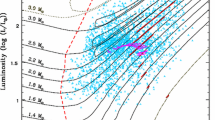Abstract
The open cluster NGC 6633 was observed with CoRoT in 2011 and simultaneous high-resolution spectroscopy was obtained with the SOPHIE and HARPS spectrographs. One of the four targets was not found to be a cluster member. For all stars we provide estimates of the seismic and spectroscopic parameters.
Access provided by Autonomous University of Puebla. Download conference paper PDF
Similar content being viewed by others
Keywords
These keywords were added by machine and not by the authors. This process is experimental and the keywords may be updated as the learning algorithm improves.
The CoRoT satellite (Convection, Rotation and planetary Transits; Baglin et al. 2006) observed the open cluster NGC 6633 in two long runs allocated from April 2011 to September 2011 (LRc07 and LRc08 in the CoRoT schedule). The red giants HD 170031 (V = 8. 20), HD 170231 (V = 8. 69), HD 170053 (V = 7. 30), HD 170174 (V = 8. 31) and the B8-star HD 170200 (V = 5. 70) were the five stars selected to be observed in the asteroseismic channel. The Seismologic Ground-Based Working Group considered very challenging to perform simultaneous radial velocity measurements to measure the amplitude of the radial velocity variations of the solar-like oscillations occurring in red giants.
The spectroscopic runs with HARPS at European Southern Observatory were scheduled from June 23 to July 3, 2011 and from 15 to 20 July, 2011. The runs with SOPHIE at Observatoire Haute Provence from May 26 to June 6, 2011, and from June 20 to July 1, 2011. Due to long exposure time requested to provide the necessary accuracies, only HD 170031 and HD 170053 could be intensively observed at both observatories. Figure 1 shows the radial velocity curves obtained from June 23 to July 1, 2011. Note that error bars are reported, but often not noticeable since they have the same size of the points.
The double-site campaign clearly put in evidence the multiperiodic behaviours of the radial velocity variation in both the well-sampled red giants. Peak-to-peak amplitudes are 60 m s−1 for HD 170053 and 40 m s−1 for HD 170031. The uncertainty on a single measurement is ±1 m s−1. It also resulted that HD 170053, HD 170231, and HD 170174 have the same mean radial velocity (around − 28 km s−1), while HD 170031 shows a completely different value (Fig. 1). The NGC 6633 radial velocity is − 25. 43 km s−1 (Kharchenko et al. 2005) and therefore we can conclude that, unlike the other three red giants, HD 170031 is not a cluster member.
The HARPS spectra were also used to accurately estimate the atmospheric parameters (effective temperature Teff, surface gravity log g, metallicity [Fe/H], microturbulent velocity ξ) and the abundances of 16 chemical species in a self-consistent manner (Morel et al. 2014), for both NGC 6633 targets and other galactic red giants. Moreover, the extensive photometric CoRoT timeseries supplied reliable estimates both for the frequency of the maximum oscillation power (ν max ) and for the large separation (Δ ν). The atmospheric parameters could be obtained from the seismic analyses, too (Table 1). The agreement is excellent, as Fig. 2 shows for the surface gravities. In particular, note the smaller error bars of the seismic values.
This study shows that spectroscopic and photometric data can be combined to describe the pulsational scenario of red giants and, in turn, make more complete models of their atmospheres.
References
Baglin, A., Auvergne, M., Barge, P., et al. 2006, in ESA Special Publication, Vol. 1306, ESA Special Publication, ed. M. Fridlund, A. Baglin, J. Lochard, & L. Conroy, 33
Kharchenko, N. V., Piskunov, A. E., Röser, S., Schilbach, E., & Scholz, R.-D. 2005, A&A, 438, 1163
Morel, T., Miglio, A., Lagarde, N., et al. 2014, A&A, 564, A119
Acknowledgements
The CoRoT space mission, launched on 2006 December 27, was developed and is operated by the CNES, with participation of the Science Programs of ESA, ESA’s RSSD, Austria, Belgium, Brazil, Germany and Spain. This work is based on observations collected at La Silla Observatory, ESO (Chile) under program LP185.D-0056.
Author information
Authors and Affiliations
Corresponding author
Editor information
Editors and Affiliations
Rights and permissions
Copyright information
© 2015 Springer International Publishing Switzerland
About this paper
Cite this paper
Poretti, E. et al. (2015). The Red Giants in NGC 6633 as Seen with CoRoT, HARPS and SOPHIE. In: Miglio, A., Eggenberger, P., Girardi, L., Montalbán, J. (eds) Asteroseismology of Stellar Populations in the Milky Way. Astrophysics and Space Science Proceedings, vol 39. Springer, Cham. https://doi.org/10.1007/978-3-319-10993-0_11
Download citation
DOI: https://doi.org/10.1007/978-3-319-10993-0_11
Published:
Publisher Name: Springer, Cham
Print ISBN: 978-3-319-10992-3
Online ISBN: 978-3-319-10993-0
eBook Packages: Physics and AstronomyPhysics and Astronomy (R0)






